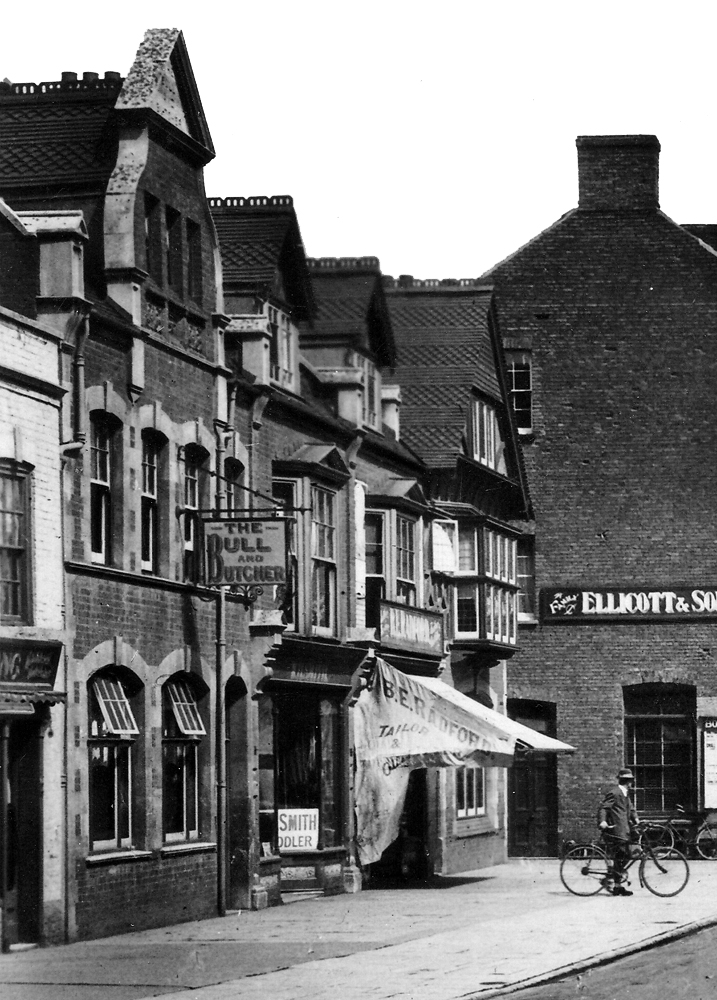Oak Apple Drive: Modern, largely complete by 2006. The name takes its lead from Old Oak Close. Built over a field called ‘the acre’, which was wooded in 1840, but clear by 1889 (TAM and OS), and another called ‘Barn Seven Acres’.
The Oaks: Wembdon. Modern, date TBC. Built over the site of Oakfield House, both names referring to the surrounding oak trees.
Oakfield Road: South portion seems to follow an old trackway leading to a cattle pit, and seems to have been called Todd’s Lane at which time there were two houses, called Ambleside and Crieff (Whitby Light and Lane Directory 1937). South portion shown in the 1939 Town Guide. The first houses were built here and the lane given new name given in the late 1920s by Fred Cox (with thanks to Lynton Rudge – Bridgwater History Facebook) Housing shown on the 1946 RAF photographic survey. Extended north as part of the cooperative housing estate by the 1967 Town Guide plan. Seems fairly treeless on the 1889 OS map, but there may have been an oak tree along one of the field boundaries here.
Oakgrove Way: (late 20th c. Bower development – date TBC) One of a series of streets in a development, mostly named after trees types and flora. Marshland on the 1840s Tithe Apportionment Map.
Oakmere Road: Part of the 2015-2016 Haygrove Park Estate estate. Name of unknown significance.
Octagon Cottages: Bath Road. Now 87-97 Lower Bath Road. Mentioned in the 1861 Census. Shown on the 1887 OS 25″ Town Plan. Five houses, in a group of two and a group of three, between which access was made to a large house and garden (presumably Octagon house?). Name of unclear significance. Still shown on the 1930 OS Map and 1946 RAF aerial photographic survey. They possibly survive as modern retail and commercial units, heavily altered, the big house and their gardens now being a depot.
Octavia Close: Post 2006 Willstock Estate, date TBC. Name of unclear significance. Built over a field called ‘Long Rap’ (TAM).
Old Basin: Immediately in front of the terrace was once the terminal basin of the Bridgwater and Taunton Canal, although the site is now a green. Shown on the 1840s Tithe Apportionment map, although in-filled by the time of the 1889 OS map. A section of the canal up to there had survived by that time, but it seems to be silted up by the 1904 OS map.
Old Dock: a group of eight buildings off of East Quay mentioned in the 1881 census and 1891 census before William’s Buildings, so presumably to the south of there. Possibly also the same as buildings in ‘Dry Dock’ mentioned elsewhere.
Old Library: 2021 development, the name being a mistaken reference to the County Library Services Headquarters: there was never a library on this site. Previously part of Dr Morgan’s School, before it moved to the Haygrove site.
Old Market Road: Construction started 2018. The road leading to, and continued into, the site of the New Market redevelopment. Built over the site of the 1935 livestock market. The name is slightly unfortunate as ‘Old Market’ always referred to Penel Orlieu, to differentiate it from this market.
Old Oak Close: Part of the c.2001 NDR development, complete by 2006. Named for the huge oak tree this street circles round, a well-known landmark before the houses were built. The field in which the tree stands was called ‘Crab Acre’ on the Tithe Apportionment Map, while that to its sound (the close straddles both) was called ‘Margery’s Wood’. The oak seems to be shown on the 1889 OS plan, although with a second very close by. A water pit, now under number 20, is marked ‘spring’ in 1889.
*Old Oak Lane: Small lane running between High Street and Clare Street. Takes its name from the adjoining pub, the Old Oak, itself first mentioned in 1802. Called ‘Old Oak Lane’ in the 1887 OS Town Plan. Called Godwyneslane (Godwin’s Lane) in 1380, named for a important family of Godwins who presumably lived there (BBA no.337, 340, Lawrence, p.33).

Old Taunton Road: See Taunton Road, old and new
Olive Way: Post 2006 Stockmoor Estate, date TBC. Given a couple of nearby streets, this is possibly just a reference to the colour.
Orchard Lane: Wembdon. The site of an orchard, the grounds of Hill Grove House. A stone coffin was discovered here in the nineteenth century: possibly a site of executions.
Orchid Way: Post 2006 Willstock Estate, date TBC. Named after a type of plant.
Orion Drive: Post 2009 Jam Factory redevelopment. Unclear significance – Some streets on this estate took nautical names associated with the River Parrett?
Orkney Close: Post 2006 Stockmoor Estate, date TBC. Presumably named after the type of sheep from the group of islands off the north coast of Scotland, fitting the Livestock theme of the estate.
Orlove Street: See Clare Street
Osborne Road: Part of the Newtown Development. Not yet built on the 1930 OS map, although a junction had been built in preparation. first appears on the 1931 Town Guide Plan. Shown as a cul-de-sac on the 1946 RAF photographic survey, terminating just north of Berrydale Avenue. Extended north by the 1955 Town Guide plan, then loops west by the 1967 Town Guide Plan. Name of unknown significance. Built over a field called Dunmead (TAM).
Oxen Drive: Construction started 2018. Part of the New Market redevelopment. Built over the site of the 1935 livestock market. Name refers to this, as several new roads here are named after cattle types (with thanks to Laura Bailey).
Oxford Terrace. Part of the Old Colley Lane, before it was divided into a cul-de-sac by the creation of the Railway Bridge in about 1873. Presumably the terrace dates to around that time. Certainly shown complete on the 1889 OS Town Plan. Name of unknown significance.
